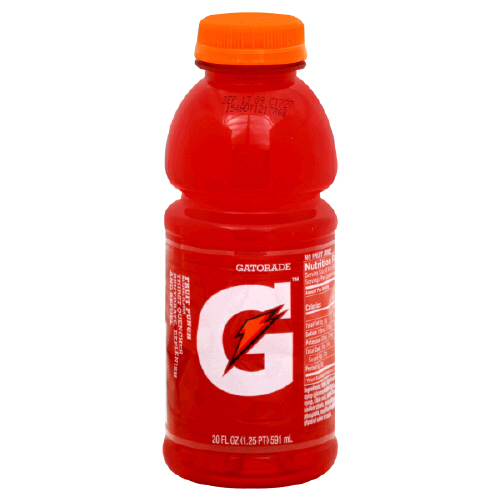Recently, a bottle of this vile liquid appeared in my too-small refrigerator:
I won't say who put it there, but let's just say his name rhymes with 'Rarling Rusband.'
Seriously, though, I don't like to pick on the Darling Husband, because he is really quite a wonderful husband. He doesn't even mind that I periodically
blog about another man.
My bitterness towards the Gatorade in the fridge is not simply that refrigerator real estate is precious, more that the contents of Gatorade are beyond lamentable. However, the DH anticipated heavy sweating during an outdoor work event, and so purchased the vile liquid. And so, we had a civil yet spirited debate about electrolyte replacement which resulted in DH requesting some of my world-famous exhaustive internet research
tm on the subject, to which I happily consented. Here is what I learned:
What are electrolytes?
Electrolytes are minerals in your bodily fluids--blood, urine, etc. Sodium, calcium, potassium, chlorine, phosphate and magnesium are all minerals that contain an electric charge. Zing! How exciting! You need electrolytes to maintain your body's natural processes. These minerals are part of the transfer mechanism of fluids, nutrients and waste. They're essential to the nervous system and muscle function. We typically get an appropriate balance from our food, and usually it isn't something we need to think about much.
How are electrolytes depleted?
Electrolytes typically become imbalanced from sweating. When we sweat, we lose water and primarily sodium. That's why sweat tastes salty.
What happens (and how do you know) if your electrolyte levels are imbalanced?
Thirst! It's the first sign most people experience that indicates a need to restore balance to your system. I found quite a list
here on the various types of electrolyte imbalances. These can be very severe situations, but most people notice thirst, dry mouth, and abdominal cramping when things start getting serious.
Who is at risk for electrolyte imbalance?
Chances are, not you. Seriously. Unless you are an endurance athlete exerting yourself for several hours on a hot summer day, you probably don't need to implement a specific protocol for electrolyte replacement. Just drink some water and eat something whole and real. And the same applies to your children.
I say this as a heavy sweat-er. I've told you before
how prone I am to sweating. Other people will be fresh as a daisy and I'll be drenched. But the duration of my workouts is typically about an hour. Simply drinking water and eating a healthy balance of real, whole food is perfectly sufficient for me and most exercisers. I've never been into sports drinks, mainly because I don't like to drink my calories. And sports drinks (even the best ones) contain sugar--the point being to get everything into your bloodstream quickly. But for most people in most situations, drinking sugar is a particularly bad idea. Sugar was designed to come in fibrous fruity packaging, which slows absorption. So no matter how sweaty I've gotten, I've just drunk water, and here I am! All these years, alive and well.
Gatorade and similar sports drinks make me crazy. Why? Because they are FULL OF CRAP. Look at the ingredients list on the bottle of one variety:
CRAP. High-fructose corn syrup, artificial colors, 14 grams of sugars in only 8oz. Sports drinks like Gatorade and Powerade used to contain
brominated vegetable oil, which is linked to all kinds of serious health problems, but manufacturers have very recently bowed to public pressure and removed that nasty stuff from their formulations. Still, these drinks are nasty. The
only good thing they do for you is replenish electrolytes and there are better ways to do that if you need it.
Apart from being vile, these drinks really push one of my buttons, and that is... wait for it...
Crap masquerading as health food
Gatorade was created back in 1965 at the University of Florida to replenish electrolytes in it's athletes. Given that Florida in summer might as well be one of Dante's circles of hell, athletes training in Florida would certainly require an electrolyte replacement strategy. But Gatorade has since morphed into it's current vile form and it is being
marketed to children, many of whom spend their days sitting in front of an X-box or at most, exercising to a Wii in an air-conditioned home.
I'm not throwing stones here because my children are currently watching
Veggie Tales while I rant on my blog, but at least they're not drinking Gatorade.
In 1985, the Gatorade Sports Science Institute was founded and wow, what a great marketing ploy that was! They might do some decent things there... I don't know... but they also spew lots of crap. Like insinuating the body's own thirst mechanism is insufficient. One of the reasons sports drinks sell is that people are told their bodies' own ability to sense thirst is unreliable, so chug some Gatorade! From what I've read, most people can just drink to thirst. If you're concerned, drink a little more.... more water, that is.
They've also tried to convince us that real, whole food is somehow insufficient to nourish us, and that is CRAP. Can I say crap any more often in this post? I don't think so. Hopefully I'm being clear. A friend of ours used to work in marketing for Gatorade. He told me he always suspected 80% of the people who bought it didn't even need it.
Now please remember, I'm just the barre mom. I like to read about health topics and I share what I learn with you, along with my colorful commentary and spicy rants. You may indeed need an electrolyte replacement strategy.
If sports drinks are vile, how can people balance electrolytes without all the crap?
Here is a great set of recipes I found from the Food Babe:
 |
| Image credit: foodbabe.com |
I did a cursory search of 'electrolyte replacement drink recipes' and found quite a few others. I've never made any myself, because as I've mentioned, I don't think I need them, but maybe I'll make one for the DH the next time he feels so inclined. Honestly, the purchase and consumption of Gatorade is pretty much the only thing DH has given me to complain about. Though he might rue the day he said, 'hey dear, maybe you should start blogging!'
And so, thus endeth the Gatorade rant. Amen.









